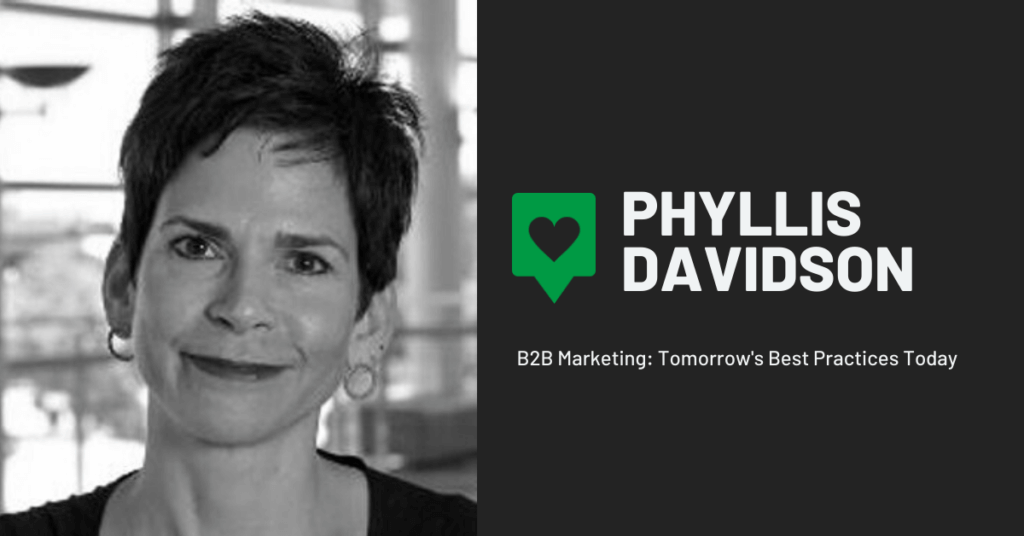In B2B Marketing: Tomorrow’s Best Practices Today, we feature expert interviews about the state of B2B Marketing and what the future holds. In this post, I interview Phyllis Davidson, Senior Research Director at Forrester.
Tell us about yourself?

I’m a mother, wife, dog and cat owner, science fiction aficionado and seasoned Silicon Valley marketer with a focus on content strategy and operations.
I joined SiriusDecisions/Forrester 4+ years ago and now spend my time on research and best practice analysis and development in support of our B2B clients.
Note: Follow Phyllis on Twitter: @PhyllisMusings
Tell us about your background in B2B marketing?
I started my career in Rochester, NY on the agency side, supporting Xerox and Kodak. I eventually made my way to Silicon Valley with roles in corporate and executive communications and demand marketing. My experience includes multiple start-ups in telecommunications and software, as well as stints at Hyperion Software and Oracle.
What’s a best practice that B2B marketers should move on from?
“The content plan must support a dynamic, omnichannel journey that enables the target audience to chart their own course.”
I assume you mean “move on from” in that it’s not actually a best practice anymore. We see a significant shift occurring in the way B2B organizations approach nurture in demand marketing.
While it’s well recognized that the days of dependence on executing programs that reflect a linear nurture path are gone, marketers are still figuring out what to do instead.
We help our clients view nurture through a multi-dimensional lens that takes into consideration multiple personas in a buying group, their knowledge needs, interaction and asset preferences, as well as marketing goals.
Ultimately, the content plan must support a dynamic, omnichannel journey that enables the target audience to chart their own course, including moving back and forth along that course in the quest to choose the right solution to meets their needs.
Tell us a best practice of tomorrow that B2B marketers should be doing today?
Here are two connected best practices to come: first, content atomization or modular content development, built on a foundation of metadata and taxonomy mastery will become the table stakes that enable AI and advanced content analytics.
Second, machine learning and AI will play a ubiquitous, significant and active role in every phase of the end-to-end content lifecycle. We have research and recommendations for both areas in our SiriusDecisions research portal.
Check out this spooky post by Phyllis:
Experiencing cadaverous content, nefarious nurtures and other scary #content planning hauntings this Halloween? Check out my trick to make your content an audience treat! https://t.co/rDxcD7HAdV
— Phyllis Davidson (@PhyllisMusings) October 31, 2019
Describe B2B marketing in three words or less?
Broad and deep.
To manage B2B marketing in the right way, organizations need to prioritize where they need to go broad, and where they need to go deep.
What’s the biggest mistake B2B brands make when doing a content audit?
Trying to audit and tag everything at once, which too often fails anyway. It’s far better to tackle a content audit in phases, starting with content attached to the most active sales play/program.
Note: Phyllis gave a presentation on content audits to the Bay Area Content Marketing Meetup. Here are photos from mutual friend Rich Schwerin:
Great #content audit preso @PhyllisMusings, thanks! HT @dshiao's @Content_Meetup cc: @so_ninjas @tendocom @ComBlu @jillwelch99 pic.twitter.com/o3cfCVXPeJ
— Rich Schwerin 🚵♂️ (@Greencognito) March 30, 2017
What’s your favorite discipline within Marketing?
Plotting the big, provocative story for an organization and mapping it into content strategy.
One must-see for visitors to the Bay Area?
There are so many things to choose from! But topping the list for sure is biking across the Golden Gate Bridge.
